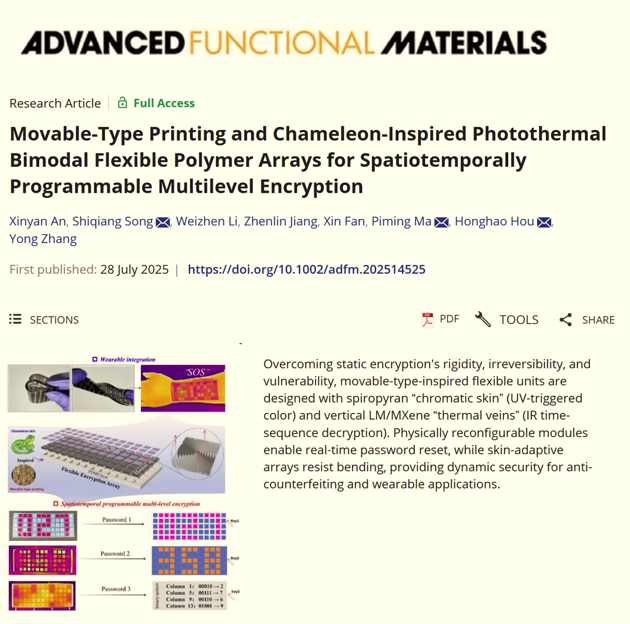Recently, Associate Professor Song Shiqiang from the School of Chemistry and Chemical Engineering guided Master's students An Xinyan and Yang Xu to publish articles titled Movable type Printing and Chameleon Inspired Photothermal Bimodal Flexible Polymer Arrays for Spatiotemporal Programmable Multilevel Encryption and Bioinsined Janus Interlocked MXene/Perovskite PDMS Composites for Integrated Thermal Visualization, Rapid heat Dissection, and ProVisualization in academic journals Advanced Functional Materials (Top of the Chinese Academy of Sciences, Impact Factor 19) and Composites Part B: Engineering (Top of the Chinese Academy of Sciences, Impact Factor 14.2), respectively. Research paper on Active Fire Safety in High Power Electronics.
Dynamic information encryption systems face critical challenges in achieving multimodal synergy, dynamic reconfigurability, and wearable compatibility. Traditional approaches relying on single-stimulus mechanisms (e.g., photochromism or thermal actuation) suffer from static architectures and vulnerability to replication. Inspired by the reconfigurable logic of movable-type printing and the chameleon's hierarchical color modulation, a bioinspired encryption paradigm is presented using photothermal bimodal flexible polymer arrays. Each array module integrates an ultraviolet (UV)-responsive photochromic layer (spiropyran/spiropyrazine derivatives) for instantaneous optical decryption and a vertically aligned thermal conductive layer (liquid metal/MXene nanocomposites) for time-resolved infrared encryption. The photochromic layer achieves instantaneous visible pattern switching with tunable fading kinetics (40–70 s), while the thermal layer leverages anisotropic heat dissipation (0.16–5.56 W m−1 K−1) to generate spatiotemporally evolving infrared signatures. Most importantly, the modular architecture enables in situ information reconfiguration through physical rearrangement, overcoming the static limitations of conventional systems. Demonstrations include multilevel security with sequential optical-thermal decryption (e.g., “027” via UV, “358”, “2769” via IR) and programmable wearable arrays conforming to curved surfaces. This work establishes a paradigm for adaptive, high-security applications in the areas of anti-counterfeiting, dynamic authentication, and confidential file transfer, bridging nanomaterial innovation with dynamic information protection.

The development of polymer-based composites that integrate high thermal conductivity, flame retardancy, and intelligent sensing capabilities is critical for advancing thermal management in modern electronics. Inspired by natural hierarchical architectures, this study introduces a Janus interlocked-structured polydimethylsiloxane (PDMS) composite, synergizing MXenenanosheets and thermochromicperovskite (MAPbxBry) for multifunctional performance. A 3D snowflake-patterned PDMS skeleton is designed to host an interconnected MXene network, achieving exceptional thermal conductivity (1.32 k/W·m, 680 % enhancement over pure PDMS) and flame retardancy (33 % reduction in peak heat release rate, 90.3 % residue retention). Simultaneously, the perovskite overlayer enables real-time temperature visualization through reversible color transitions (yellow → red → black) within 15 s, triggered by phase transformations at critical thresholds (60–120 °C). The Janus architecture spatially decouples functional units while ensuring synergistic interactions, offering dual protection against thermal hazards: rapid heat dissipation via MXene pathways and proactive fire warning via thermochromic responses. Demonstrated in battery thermal management, the composite reduces surface temperatures by 19.1 °C under high discharge rates (6.16C), highlighting its potential for safeguarding miniaturized and high-power electronic systems. This work pioneers a multifunctional material platform that synergizes “sense-conduct-protect” mechanisms, providing a transformative solution for next-generation electronics and energy storage systems.

This work was financially supported by the National Natural Science Foundation of China (No. 52003151), the Natural Science Foundation of Shanghai (No. 24ZR1426900), and Shanghai Student Innovation Training Program (No. cs2504004). X. Yang and Y. Li contributed equally to this work.
